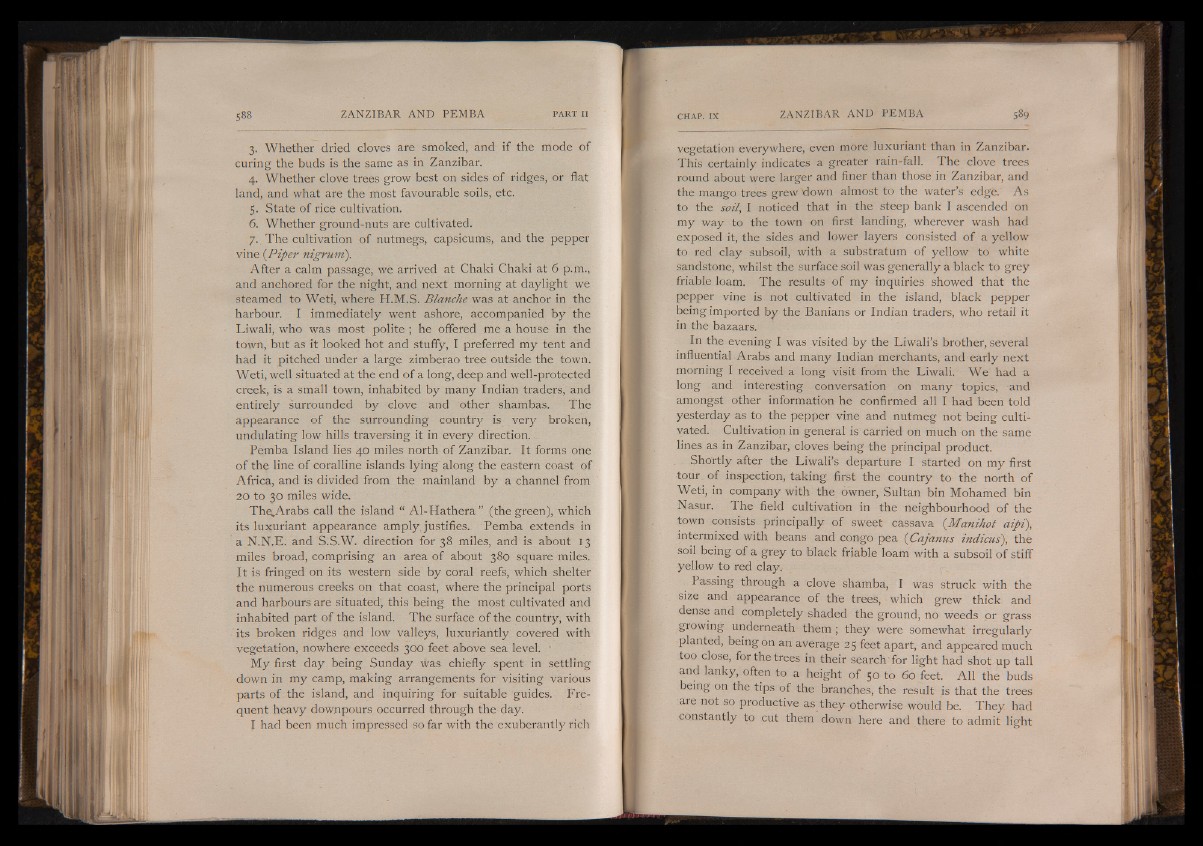
3. Whether dried cloves are smoked, and if the mode of
curing the buds is the same as in Zanzibar.
4. Whether clove trees grow best on sides of ridges, or flat
land, and what are the most favourable soils, etc.
5. State of rice cultivation.
6. Whether ground-nuts are cultivated.
7. The cultivation of nutmegs, capsicums, and the pepper
vine (Piper nigrum).
After a calm passage, we arrived at Chaki Chaki at 6 p.m.,
and anchored for the night, and next morning at daylight we
steamed to Weti, where H.M.S. Blanche was at anchor in the
harbour. I immediately went ashore, accompanied by the
Liwali, who was most polite; he offered me a house in the
town, but as it looked hot and stuffy, I preferred my tent and
had it pitched under a large zimberao tree outside the town.
Weti, well situated at the end of a long, deep and well-protected
creek, is a small town, inhabited by many Indian traders, and
entirely surrounded by clove and other shambas. The
appearance of the surrounding country is very broken,
undulating low hills traversing it in every direction.
Pemba Island lies 40 miles north of Zanzibar. It forms one
of the line of coralline islands lying along the eastern coast of
Africa, and is divided from the mainland by a channel from
20 to 30 miles wide.
The^Arabs call the island “ Al-Hathera” (the green), which
its luxuriant appearance amply, justifies. Pemba extends in
a N.N.E. and S.S.W. direction for 38 miles, and is about 13
miles broad, comprising an area of about 380 square miles.
It is fringed on its western side by coral reefs, which shelter
the numerous creeks on that coast, where the principal ports
and harbours are situated, this being the most cultivated and
inhabited part of the island. The surface of the country, with
its broken ridges and low valleys, luxuriantly covered with
vegetation, nowhere exceeds 300 feet above sea level.
My first day being Sunday was chiefly spent in settling
down in my camp, making arrangements for visiting various
parts of the island, and inquiring for suitable guides. Frequent
heavy downpours occurred through the day.
I had been much impressed so far with the exuberantly rich
vegetation everywhere, even more luxuriant than in Zanzibar.
This certainly indicates a greater rain-fall. The clove trees
round about were larger and finer than those in Zanzibar, and
the mango trees grew down almost to the water’s edge. As
to the soil, I noticed that in the steep bank I ascended on
my way to the town on first landing, wherever wash had
exposed it, the sides and lower layers consisted of a yellow
to red clay subsoil, with a substratum of yellow to white
sandstone, whilst the surface soil was generally a black to grey
friable loam. The results of my inquiries showed that the
pepper vine is not cultivated in the island, black pepper
being imported by the Banians or Indian traders, who retail it
in the bazaars.
In the evening I was visited by the Liwali’s brother, several
influential Arabs and many Indian merchants, and early next
morning I received a long visit from the Liwali. We had a
long and interesting conversation on many topics, and
amongst other information he confirmed all I had been told
yesterday as to the pepper vine and nutmeg not being cultivated.
Cultivation in general is carried on much on the same
lines as in Zanzibar, cloves being the principal product.
Shortly after the Liwali’s departure I started on my first
tour of inspection, taking first the country to the north of
Weti, in company with the owner, Sultan bin Mohamed bin
Nasur. The field cultivation in the neighbourhood of the
town consists principally of sweet cassava (Manihot aipi),
intermixed with beans and congo pea (Cajanus indicus), the
soil being of a grey to black friable loam with a subsoil of stiff"
yellow to red clay.
Passing through a clove shamba, I was struck with the
size and appearance of the trees, ■ which grew thick and
dense and completely shaded the ground, no weeds or grass
growing underneath them; they were somewhat irregularly
planted, being on an average 25 feet apart, and appeared much
too close, for the trees in their search for light had shot up tall
and lanky, often to a height of 50 to 60 feet. All the buds
being on the tips of the branches, the result is that the trees
are not so productive as they otherwise would be. They had
constantly to cut them down here and there to admit light